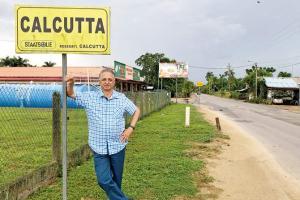The exact answer is 14,998 kms, and you have to cross two oceans to get there. And then all you'll feel is confused

Homesick, the early labourers in Suriname had built a settlement along the Suriname River after they were freed, and named it Calcutta. Pic/C Y Gopinath
 For the first time in my life I'm embarrassed to be Indian," said my friend Arvind. "I cannot believe I am seriously considering which other countries I would rather be citizen of."
For the first time in my life I'm embarrassed to be Indian," said my friend Arvind. "I cannot believe I am seriously considering which other countries I would rather be citizen of."
ADVERTISEMENT
Arvind is a global Indian, Punjabi by birth, Hindu by default, and proud to be part of a massive democracy that had till recently steadfastly remained secular against all odds.
In a world where religion and politics sleep together and you are increasingly unwelcome if you are different from the majority, India has stood as a beacon for diversity.
The Citizenship Amendment Act makes me cringe too. I feel bottomless shame at a government that can nakedly exclude a single major religion while piously proclaiming its own beneficence and compassion for the persecuted. Like Arvind, I too feel bereft and abandoned by India, dismayed by where she is being dragged today. Like him, I too feel there is nowhere left to run.
Then I think of Paramaribo, the tiny capital town of South America's smallest nation. You've not heard of it. It's called Suriname.
I was there in 2016. With the weekend open ahead of me, I strolled through the environs of the Torarica Resort where I was staying. Suriname is not big; its entire population could fit comfortably into Dadar, Mumbai. Nearly 65% or about 3,78,000 of the country's people live in its one large, rather provincial capital city, Paramaribo. It might remind you of Dehradun in the old days.
Not a furlong from the hotel was a park built around a silver-coloured statue of a couple. He reminded me of an old-time coolie at Howrah station with a gamcha over his shoulder. By his side was his traditional wife with a bundle of clothes. The placard below said: Baba en Mai. They are regarded as the founding couple of Suriname.
The spot where the statue stood was called Coolie Landing. So — he was a coolie. He was from Calcutta.
Maiba, as they are known locally, were indeed from Bengal. A few questions, a few Google searches, and an amazing story began to emerge. Except for a patina, barely 1%, of expatriates, nearly everyone in Suriname comes from families that once worked as slaves on plantations owned by the Dutch colonisers. I was in a country ruled by the very people who were once its suppressed minorities.
A large number of them were blacks shipped in from Ghana, another Dutch colony, and workers from the Dutch East Indies (now Indonesia). Others were brought from China as indentured labourers, and yet another contingent was enslaved from the native Americans in nearby forests.
Needing yet more hands, the Dutch asked their fellow colonisers, the British, if they could spare a few warm bodies from one of their colonies. The British thought at once of Bengal, a state they were not particularly fond of. They rounded up a crowd of able-bodied workers from Bengal, Bihar, Jharkhand and eastern Uttar Pradesh and sent them off in a slave ship as indentured workers, destination unknown.
Suriname's 2012 census shows Hindus as the second largest group in Suriname, comprising 22.3%, next to Christians (48.4%). Muslims, mostly from Java or India, make up about 13.9% of the population.
No one is oppressed or excluded. They not only rule their country together but they marry together, as I found out when I took a taxi.
The taxi driver looked completely Bengali except that his hair was frizzy like an African's. His eyes — well, his eyes had an epicanthic fold, like Chinese do. He spoke in a language that sounded strangely like a cross between Bengali and Creole.
His grandfather on his father's side had been Chinese, and his mother, who was mostly Bengali, had married a Maroon — that is, half Ghanaian and half Dutch. His grandmother on his mother's side was native American. He wasn't really quite sure what he was any more, other than a glorious, happy mix of cultures, religions, beliefs and diversities, completely content to be in this humble, unknown melting pot called Suriname.
"Where were you born?" I asked.
"Calcutta," he said.
"How can that be?" I asked. "It's two oceans away."
"Not that Calcutta," he said.
The next day, he drove me to his birthplace two hours outside Paramaribo. Homesick, the early labourers had built a settlement along the Suriname River after they were freed, and named it Calcutta.
Across the river stood another nostalgic village, this one called Bombay.
Christians, Hindus, Muslims, Jains and Buddhists from different parts of India live in Calcutta and Bombay, Suriname. They celebrate each other. Suriname represents a respectful, harmonious, diverse world that is rapidly receding from our lives.
When someone asks me how far Mumbai is from Bombay, I reply, "Very far — exactly 14,998 kilometres as the crow flies."
Here, viewed from there. C Y Gopinath, in Bangkok, throws unique light and shadows on Mumbai, the city that raised him. You can reach him at cygopi@gmail.com Send your feedback to mailbag@mid-day.com
The views expressed in this column are the individual's and don't represent those of the paper
Catch up on all the latest Crime, National, International and Hatke news here. Also download the new mid-day Android and iOS apps to get latest updates
 Subscribe today by clicking the link and stay updated with the latest news!" Click here!
Subscribe today by clicking the link and stay updated with the latest news!" Click here!






